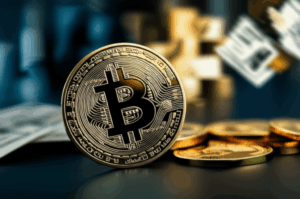Bitcoin Holds Firm Above $105K as Geopolitical Storm Brews
In a financial landscape increasingly defined by volatility and uncertainty, Bitcoin, the world’s leading cryptocurrency, has demonstrated remarkable resilience, firmly maintaining its position above the $105,000 threshold. This steadfast performance comes at a time when global geopolitical tensions are escalating, casting long shadows over traditional markets and prompting investors to re-evaluate their asset allocation strategies. The ability of a digital, decentralized asset to not only weather but seemingly thrive amidst a brewing international storm marks a pivotal moment in its journey from a niche technology to a recognized component of the global financial system.
The current geopolitical climate is multifaceted and complex. From regional conflicts and trade disputes to inflationary pressures and shifts in monetary policy across major economies, the confluence of these factors creates an environment ripe for investor anxiety. Historically, such periods of heightened instability have often seen a flight to traditional safe-haven assets like gold, government bonds, or select reserve currencies. However, Bitcoin’s recent behavior suggests a growing narrative that positions it as a comparable, perhaps even superior, alternative for those seeking to preserve capital in turbulent times. Its decentralized nature, operating independently of any single government or financial institution, offers a compelling draw for investors wary of the systemic risks inherent in centralized systems. This independence means Bitcoin is not subject to the same national capital controls, inflation policies, or political whims that can devalue fiat currencies or destabilize conventional markets.
A key factor contributing to Bitcoin’s perceived strength is its inherent scarcity. With a hard cap of 21 million coins, its supply is mathematically constrained, a stark contrast to fiat currencies which can be printed at will, often leading to devaluation. In an era where central banks have resorted to unprecedented quantitative easing, diluting the purchasing power of traditional money, Bitcoin’s fixed supply acts as a hedge against inflation. This “digital scarcity” narrative resonates particularly strongly with a younger demographic of investors, who have grown up in a world where digital assets are increasingly commonplace and trust in traditional financial institutions has sometimes wavered. The transparent, immutable ledger of the blockchain further reinforces this trust, providing an undeniable record of ownership and transactions.
Beyond its intrinsic properties, Bitcoin’s growing institutional adoption and improved market infrastructure have undoubtedly played a role in its newfound stability. The entry of major financial players, the development of regulated investment vehicles, and increasing liquidity have matured the market, making it more robust and less susceptible to the wild price swings that characterized its earlier years. While historically volatile, the current scenario, where it holds firm above $105K despite significant external pressures, suggests a maturing asset class. This resilience sends a powerful signal to both retail and institutional investors that Bitcoin is evolving beyond speculative asset to a legitimate store of value and a potential hedge against global instability. For young adults building their portfolios, understanding these dynamics is crucial, as Bitcoin offers a diversification opportunity that deviates significantly from traditional asset classes, potentially offering uncorrelated returns during periods when conventional investments face headwinds.
As the geopolitical landscape continues to evolve, the performance of assets like Bitcoin will be closely watched. Its ability to maintain a strong valuation amidst widespread uncertainty not only validates its proposition as “digital gold” but also accelerates its mainstream acceptance. This moment could be pivotal, solidifying Bitcoin’s role as a vital component of a diversified portfolio in a rapidly changing world, and setting a precedent for how digital assets might serve as critical anchors in future economic storms. The narrative is shifting from pure speculation to strategic hedging, inviting a broader range of participants into the digital asset ecosystem and reshaping our understanding of what constitutes a safe haven in the 21st century.





